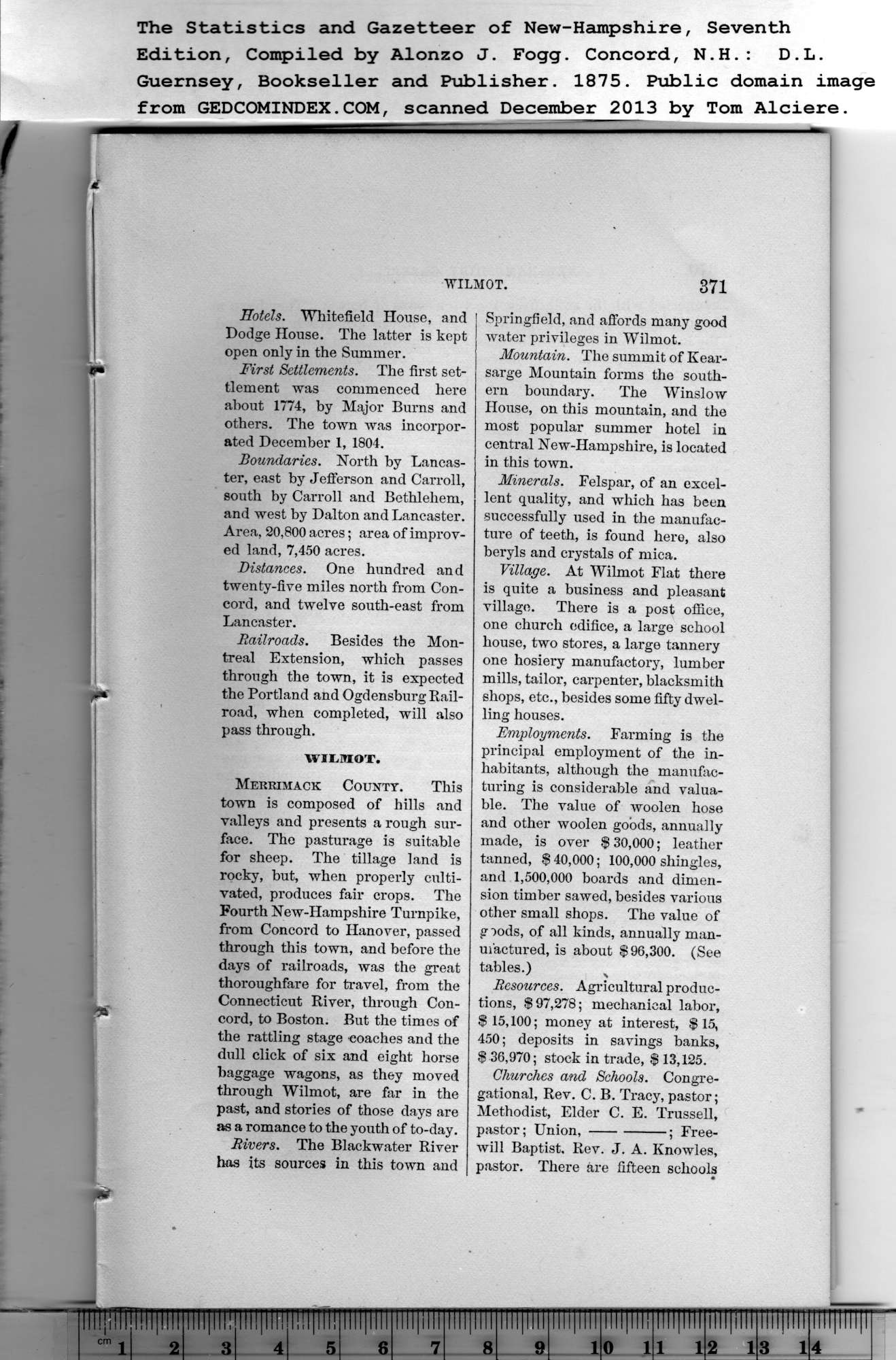|
Hotels. Whitefield House, and
Dodge House. The latter is kept
open only in the Summer.
The Statistics and Gazetteer of New-Hampshire, Seventh
Edition, Compiled by Alonzo J. Fogg. Concord, N.H.: D.L.
First Settlements. The first set-
tlement was commenced here
about 1774, by Major Burns and
others. The town was incorpor-
ated December 1, 1804.
Boundaries. North by Lancas-
ter, east by Jefferson and Carroll,
south by Carroll and Bethlehem,
and west by Dalton and Lancaster.
Area, 20,800 acres; area of improv-
ed land, 7,450 acres.
Distances. One hundred and
twenty-five miles north from Con-
cord, and twelve south-east from
Lancaster.
Railroads. Besides the Mon-
treal Extension, which passes
through the town, it is expected
the Portland and Ogdensburg Rail-
road, when completed, will also
pass through.
WILMOT.
Merrimack County. This
town is composed of hills and
valleys and presents a rough sur-
face. The pasturage is suitable
for sheep. The tillage land is
rocky, but, when properly culti-
vated, produces fair crops. The
Fourth New-Hampshire Turnpike,
from Concord to Hanover, passed
through this town, and before the
days of railroads, was the great
thoroughfare for travel, from the
Connecticut River, through Con-
cord, to Boston. But the times of
the rattling stage coaches and the
dull click of six and eight horse
baggage wagons, as they moved
through Wilmot, are far in the
past, and stories of those days are
as a romance to the youth of to-day.
Rivers. The Blackwater River
has its sources in this town and |
371
Springfield, and affords many good
water privileges in Wilmot.
Mountain. The summit of Kear-
sarge Mountain forms the south-
ern boundary. The Winslow
House, on this mountain, and the
most popular summer hotel in
central New-Hampshire, is located
in this town.
Minerals. Felspar, of an excel-
lent quality, and which has been
successfully used in the manufac-
ture of teeth, is found here, also
beryls and crystals of mica.
Village. At Wilmot Flat there
is quite a business and pleasant
village. There is a post office,
one church edifice, a large school
house, two stores, a large tannery
one hosiery manufactory, lumber
mills, tailor, carpenter, blacksmith
shops, etc., besides some fifty dwel-
ling houses.
Employments. Farming is the
principal employment of the in-
habitants, although the manufac-
turing is considerable and valua-
ble. The value of woolen hose
and other woolen goods, annually
made, is over $30,000; leather
tanned, $ 40,000; 100,000 shingles,
and 1,500,000 boards and dimen-
sion timber sawed, besides various
other small shops. The value of
g oods, of all kinds, annually man-
ufactured, is about $96,300. (See
tables.)
Resources. Agricultural produc-
tions, $97,278; mechanical labor,
$15,100; money at interest, $15,
450; deposits in savings banks,
$ 36,970; stock in trade, $ 13,125.
Churches and Schools. Congre-
gational, Rev. C. B. Tracy, pastor;
Methodist, Elder C. E. Trussell,
pastor; Union,--; Free-
will Baptist, Rev. J. A. Knowles,
pastor. There are fifteen schools |
